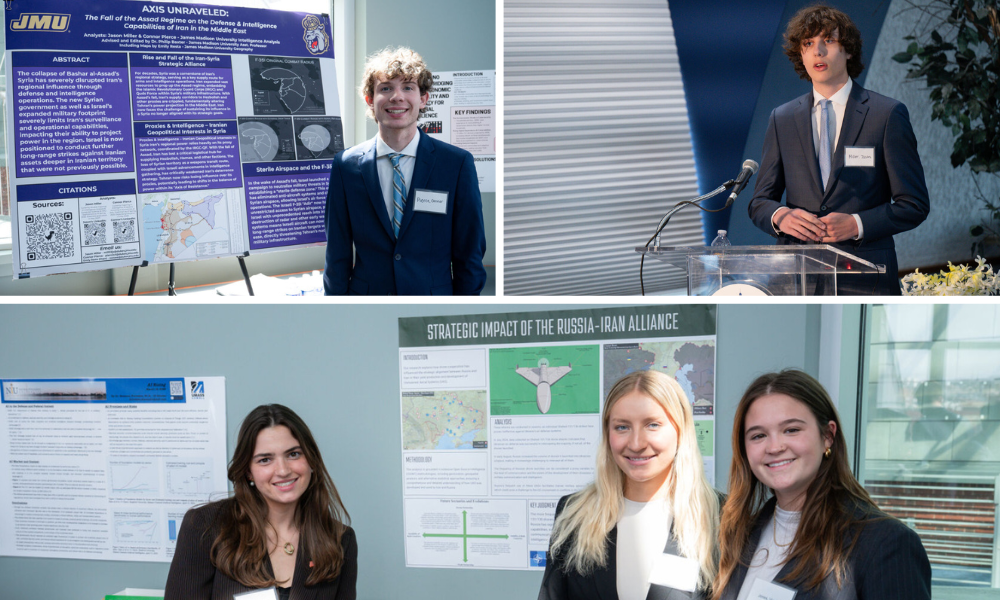IA students present at National Intelligence Symposium
News
Five JMU Intelligence Analysis (IA) students stepped into the spotlight, presenting timely, impactful research at the 2025 Intelligence Studies Consortium’s Annual Symposium. Held at Howard University and hosted by the Office of the Director of National Intelligence, the Symposium brought together students, faculty, and intelligence professionals from across the country, representing nine universities and over 130 participants.
Jason Miller and Connor Pierce presented their research, “The Fall of the Assad Regime on Iranian Defense & Intelligence Capabilities,” which explored the regional ripple effects of the Syrian government’s collapse, particularly on Iran’s intelligence infrastructure and strategic posture.
"Connor and I met during the fall semester and quickly discovered our shared interest in Middle Eastern politics,” said Miller. “When Assad's regime fell in December, we realized this was a pivotal moment—one we could analyze in real time.”
Taylor Hankins, Victoria Jones, and Katie Fricke presented “Dangerous Friends: Russian-Iranian Drone Cooperation.” Their research analyzed the evolving strategic alliance between Russia and Iran through drone technology.
“We wanted to choose an emerging and globally relevant topic,” said Hankins. “Our ultimate goal was to produce something worthy of publication through the NATO Defense College.”
Both teams were guided by IA professors Philip Baxter, Giangiuseppe Pili, and Tim Walton, whose mentorship helped shape their research and sharpen their analytical focus.
“Having our undergraduate students selected to present at a symposium that typically features graduate-level work from universities in the D.C. area and Northeast speaks volumes about their dedication and the strength of their research,” said Baxter. “They took on challenging intelligence questions and produced innovative research that held its own in a room full of advanced scholars and practitioners.”
What makes this success even more impressive is how early they are in the IA Program—Pierce just completed his first course, and Miller only a few more.
“Assignments like threat assessments, foreign policy analysis, and hypothesis testing gave us the foundation to tackle this project professionally,” Miller said. “The IA program teaches you to think critically, communicate clearly, and approach global issues with skepticism and empathy.”
Hankins, Jones, and Fricke noted that working closely with Baxter helped bring focus to their evolving research and challenged them to produce work that could hold up on a national stage. “We were treated like peers,” said Jones. “That kind of mentorship helped us grow and raise our expectations for what we could accomplish.”
The Symposium wasn’t just a chance to showcase their work—it was a learning experience that expanded the students’ confidence, networks, and career aspirations. “Just getting there was the biggest achievement,” said Miller. “Being one of the few student teams selected to present in front of a panel was the icing on the cake.” “It was exciting to share our process and hear how other students approached similar problems,” added Jones.
“This reaffirmed that I made the right choice in pursuing intelligence analysis,” said Hankins. “It helped me see how our work as students can truly impact national and international security conversations.”
“This project made me realize how much I enjoy research and working with a dedicated team,” said Jones. “I want to keep doing this kind of work—solving complex problems, collaborating, and creating something we can be proud of.”
Miller and Pierce are pursuing publication of their research. “Once finals wrap up, we’ll begin preparing the paper for submission,” Miller said.
The IA Program blends real-world relevance with academic rigor. The program emphasizes analytical tradecraft, open-source intelligence gathering, and scenario-building—skills students apply in and out of the classroom.
